![]()
| Nepal | Everest Region |
Mountaineering Gear
Plastic Boot and Crampon
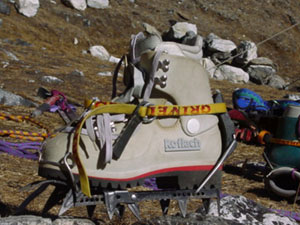 |
Plastic boots
are insulated against the cold and inflexible to hold the crampon firmly
in position.
Crampons come in 2 types: step-in (pictured) and strap-on. Left and right are determined by the buckle. Always position the buckle on the outside so the loose end of the strap doesn't catch on the opposite boot when walking. |
Ice Axe and Ice Hammer
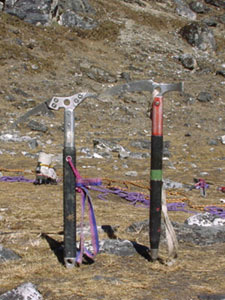 |
Ice Axe (left):
a shaft (in black) for holding, a pointed beak for planting and a flat
spade for digging.
Ice Hammer: a shaft for holding, a pointed beak for planting, and a hammer head for tapping in ice screws and banging in snow bar and ice axe anchors. The sling attached to the ice axe and ice hammer has the dual purpose of wrist support when climbing and a carabinier attachment point for belaying or rescue. Ice axes with angled handles are for steep climbs having an incline greater than 75°. The angled shaft reduces battering of the knuckles on the ice when planting the beak. For less steep climbs, a straight shaft is easier to use. |
Harness
 |
A harness wraps around the waist and thighs. The buckles on each support must be tight and looped-back to prevent loosening during use. A locking carabinier is attached to the front of the harness. Any additional gear such as rope or figure-of-8 is attached to the carabinier. |
Rope and Sling
 |
There are 2
types of rope: static and dynamic. Dynamic rope is used by climbers
because it has elasticity that can absorb some momentum in case of a
fall. Climbing ropes come in 9mm, 10mm, and 10.5mm diameters. Climbers
typically use two 9mm ropes or one 10mm rope. If anchored staggered, the
use of two 9mm ropes is safer than one 10mm rope.
Slings attach to two or more anchors to distribute the weight on the rope between anchors. |
Carabiniers
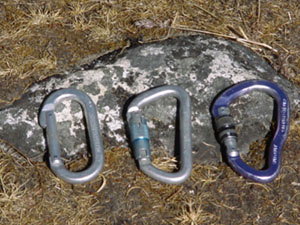 |
The 3 types of carabiniers are (left to right) plain, lock, and screw. The gate of the plain carabinier doesn't lock and is least safe. The gate of the lock carabinier automatically spring-locks and the gate of the screw carabinier is manually turned to lock. It's always best to use the lock or screw carabinier when climbing. |
Jumer
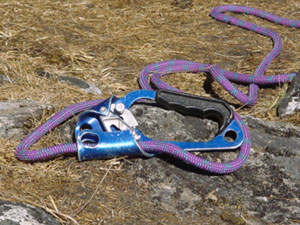 |
A jumer (also called an ascender) permits the rope to slide through only one direction. Two jumers, one in the hand overhead and one below the thigh, are used for fixed-line climbs. 2 jumers, 2 carabiniers, and an ice axe can also be configured into a crevasse rescue jet-pulley system. |
Snow Bars and Ice Screw
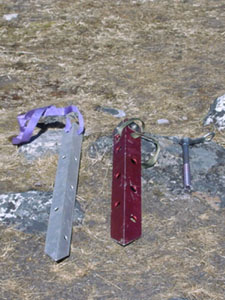 |
Snow bars and
ice screws are anchors used in ascent and descent when there is risk of
fall.
Snow bar: Using an ice hammer, the snow bar is pounded all the way into a small crevasse with the center 90° edge facing downhill. Placement must be such that neither the downhill nor the uphill climber risk extracting the snow bar by tugging on the climbing rope. Most accidents happen with the uphill climber yanks the snow bar free. Ice screw: After loose snow is cleared, the ice screw is tapped into the ice lightly while being turned. When ice comes out the top core of the ice screw, the screw is secure. |
ATC and Figure-of-8
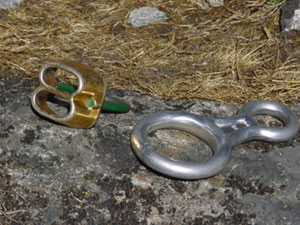 |
ATC: Attached
to a carabinier on a harness and used for belaying one or two ropes.
Figure-of-8 (also called a descender): Attached to a carabinier on a harness. Can belay one rope. Also used for rapid rappel down a fixed rope. |
Extender
| An extender (also called a quick draw) is a short piece of sling with carabinier attachments on either end. An extender distances the rope from an anchor and the climbing surface to limit rope wear. |
Copyright © 2000-2002 Wes and Masami Heiser. All rights reserved.